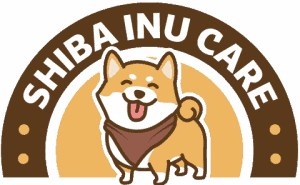This post contains affiliate links.
With aggression being a common behavioral trait in Shiba Inus I wanted to do my best to minimize the odds of someone being bitten or embarrassed in a social situation.
Shiba Inus are known for their stubbornness and short tempers. Shibas are commonly territorial, possessive over toys, food guarding, and will snap at other pets if they feel threatened. A proper training and socializing routine, along with frequent walks, helps minimize these aggressive behaviors.
Everything I’ve been able to learn from asking people, online research and good old trial-and-error is listed below. Feel free to continue reading if you’re interested.
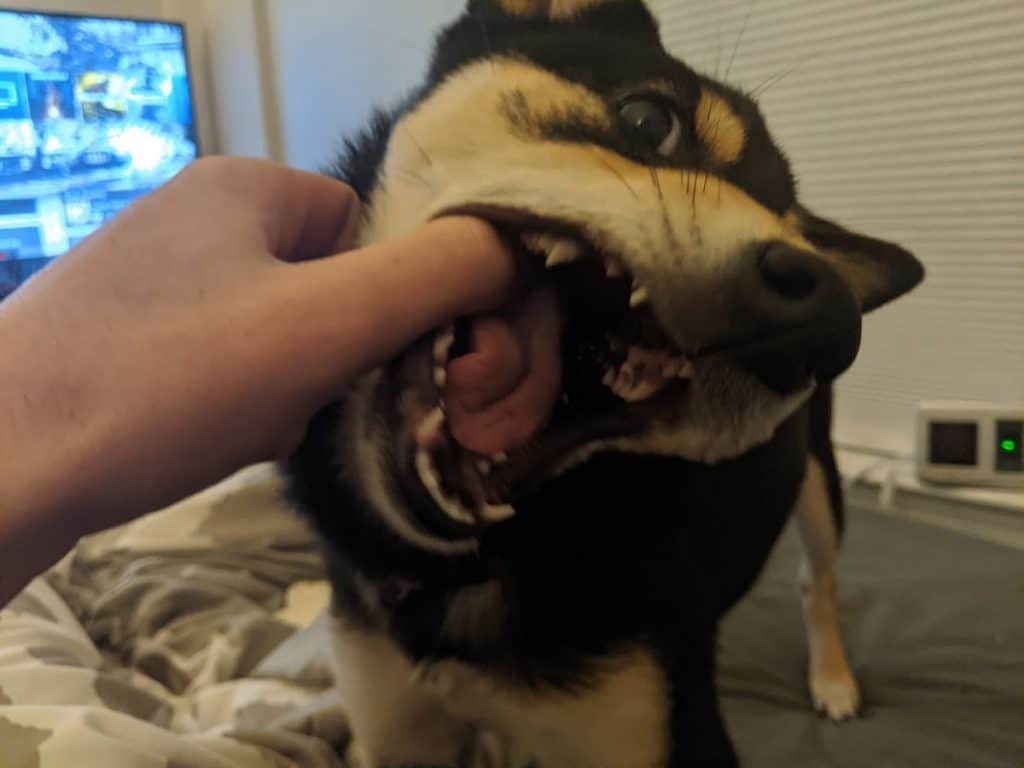
Early Warning Signs Of Aggression
There are 6 different signs of Shiba Inu aggression, which fall into one of three different categories: visual, verbal, and physical cues. Pets and other animals don’t immediately jump out to bite something or someone, there’s a build-up. Let’s break that down:
Visual Signs Of Aggression
You can learn a lot about what a Shiba Inu is thinking or feeling by just watching them. A wagging tail means their happy or excited while a low tail shows fear or stress. When stressed Shiba Inus typically drop their tail, then start showing their teeth.
Both are an early warning of what’s to come and their way of saying “I don’t like this, please stop”. If things don’t change they will start voicing their discomfort.
Verbal Signs Of Aggression
Shiba Inus are alarmingly verbal, have a vast vocabulary, and love speaking their minds compared to other dogs. From happy to sad, or good to bad, your Shiba will let you know what their feeling.
When a Shiba Inu is stressed or agitated they’ll start to growl and then bark. This is their final non-physical warning before jumping into action.
Physical Signs Of Aggression
Physical cues are your third and final sign of aggressive behavior. The gloves are coming off and the teeth are coming out unless you break things up. If their visual signs are ignored, and their verbal warnings are brushed off, the last thing your Shiba has to do is stand their ground and fight, if they weren’t able to escape.
Physical aggression typically starts with snapping and light lunging and ends with a full lunge followed by a bite. Most pets don’t want to commit to a fight if they don’t have to, which hints at the final warning before action.
Knowing what to look for is key when it comes to de-escalating a potential conflict with your Shiba Inu. Once things settle down the next thing you want to do is take a step back and figure out what caused this to happen. There are different types of aggressive behavior, and each one has its own build-up and solution.
Understanding Their Behavior
It’s important to know what you are in for. Shiba Inus are an ancient hunting dog bred for a sturdy body, vast amounts of energy, an independent personality, and an exceptionally high prey drive.
Those aspects of the breed are what you are contesting with when it comes to aggressive behaviors. Knowing the different types of behavioral problems you may run into give you a better understanding of this dog breed.
It also explains why a consistent training routine, exercise schedule, and social interactions are a Shiba’s best friends.
What Not To Do When Managing Aggressive Behaviors
Before we get into the different types of aggression and how to manage them it’s essential that you know what to and not to do. There are two types of behavioral reinforcement, positive and negative.
Positive Reinforcement Consists Of Things Like Praise, Treats, And Attention.
This uses high-value motivators to encourage your Shiba Inu to repeat the actions they just performed. Dogs have an associative memory, you have roughly a 6-second window to either reward or ignore their actions.
Negative Reinforcements Include Yelling, Hitting, Rough Grabbing, And More.
These actions only serve to stress a dog out and ultimately cause them to fear you. Shiba Inus thrive on both habits and strong bonds, and if they can’t trust you with either, they become aggressive. Shibas are loyal family dogs, it’s difficult to repair that bond once it’s been broken.
Be sure to keep this in mind when tackling every situation you find yourself in. Shibas are smart dogs, they notice when you are frustrated or sad and feed off those emotions.
If you are afraid of something while walking them and tighten their leash, they feel that stress and become standoffish or aggressive around others.
There Are 5 Common Types Of Aggression
While every Shiba has their own likes, dislikes, quirks, and way of making their opinions known, all of them follow a similar thought process in the examples I’m about to list below. I’m also going to share what has worked for me, just know you may need to make some adjustments so they work best for your unique pet and situation.
Territorial Aggression
Territorial aggression starts when a Shiba Inu feels like something has invaded their area, or “territory”. This type of aggressive behavior can be direct at people, other pets, or wild animals. You generally see this outside around your yard, inside your house, or rarely inside your vehicle.
Your goal in this situation is to gain control of your dog so they don’t have a chance to lash out. Some steps you can take are:
- Get your Shiba Inu to sit. Using their leash or grabbing ahold of their collar/harness helps.
- Have them stay seated until they’re calm. This teaches them to settle on command.
- After your Shiba has calmed down and is sitting still, give them a reward. This turns that teaching into a mini-training session. Making them more likely to do better next time.
Do know this kind of aggression can start at any time. The best way to prevent territorial aggression is by socializing your Shiba Inu, especially while they’re young. On average, younger Shibas who learn how to properly interact with other people and animals grow up happier, healthier, and with both less stress and anger issues.
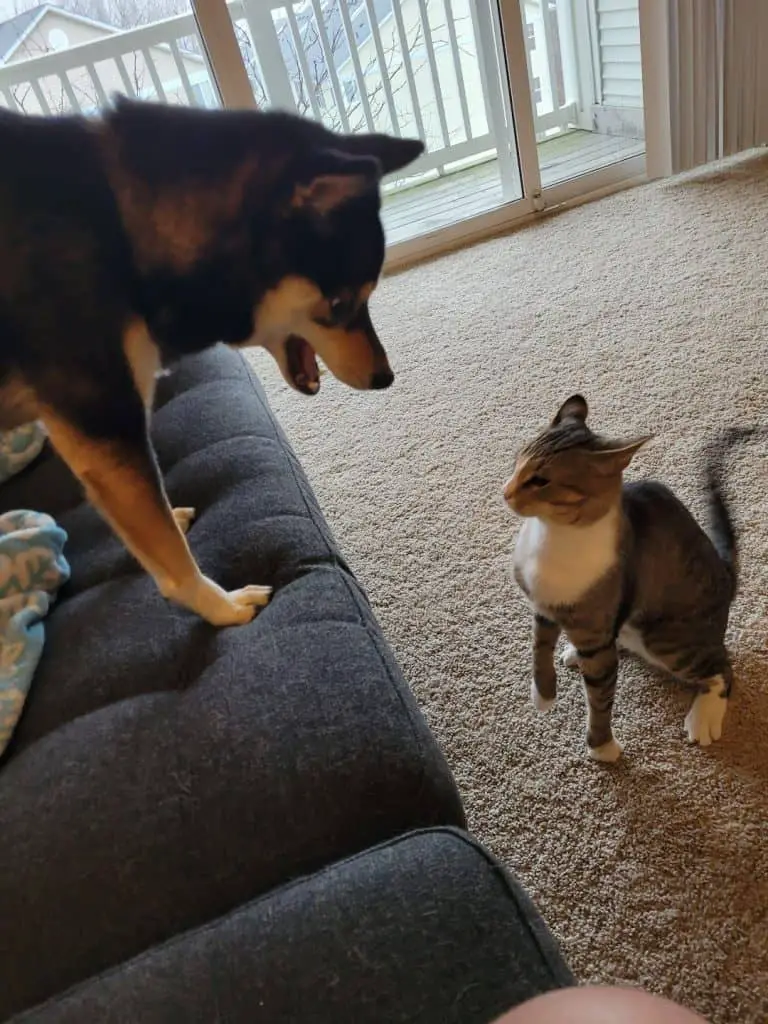
I personally haven’t had any territorial issues with my Shiba Inu, I actually have the opposite issue with her, she can’t wait to meet people.
This over-excitement to meet someone is tagged as a lack of “impulse control”. Common symptoms are over-excitement, a failure to listen to commands, happily barking at who has their attention, chasing after them, and jumping up onto their target. Usually with people at the front door.
I bring this up because you handle territorial behaviors in a similar way to over-excited ones. Here’s what I’ve had success with:
- I get control over her and her actions. I do this by holding onto her collar, putting her on a leash, or in an enclosed area. Like another room, playpen, or a secured outdoor balcony.
- Focus on keeping her seated and calm while having our guests ignore her.
- After she’s settled down, and our guest(s) are ready, I slowly walk her over and let them interact with her.
- If she’s calmed down, I let her go, if she’s still worked up, I restart at step 2.
Food-Based Aggression
Shiba Inus are naturally stubborn and possessive, making food-based aggression or food guarding common. Food-based aggression shows as a stiffening of their body, showing teeth, and growling followed by snapping and biting. This type of aggression typically starts at a young age.
While food guarding usually starts while a Shiba Inu is a young puppy, it’s not uncommon for adult Shibas to start seemingly out of nowhere. Food guarding can be directed at anybody, or anything, perceived as a threat while a Shiba Inu is eating. Their main concern is having their food or treats stolen.
For the best results, you want to get your Shiba Inu used to people and other pets being near their food while they’re a puppy. I’ve had success with:
- Hand-feeding Faith, my female Shiba Inu, kibble out of my hand for the first week while calmly talking to and petting her.
- After she was comfortable with me being around her and her food while she ate I transitioned her to eating out of a bowl.
- For the next 2 weeks, I made a point of being next to her while she ate. Talked to her in a friendly tone, giving her compliments, petting her back and head, and occasionally putting my hand in her bowl to block her. At times I would grab a handful of her food to see her reaction.
- Once I was confident food aggression wasn’t an issue, I stopped interacting with her every time she ate and instead occasionally checked on her every few weeks by interrupting her.
As she grew up, I moved into an apartment with a roommate who had a cat, which she’s never been around one. Soon after she started showing signs of food aggression towards our new fluffy roommate.
Whenever Mars, our cat, walked near her food bowl Faith would start showing teeth and begin to growl. If the cat got any closer she’d snap at him and chase him away. I’ve been able to minimize this by feeding them in separate rooms, and here’s why I did that:
- Separating their food bowls. They never ate right next to each other, but I started out by making sure her food bowl was in an open space everyone could see while the cat’s food bowl was on a table just out of Faith’s reach.
- In case something happens your cat should always have a safe place to escape to.
- Disrupting food guarding behavior. Whenever my Shiba Inu would start to tense up and growl I would snap to break her attention. This forced her to focus on me, stopping the behavior and occasionally scaring our cat away.
- Over time both of them have learned to respect each other’s “area”, the place their food and water bowls are. But it’s never perfect.
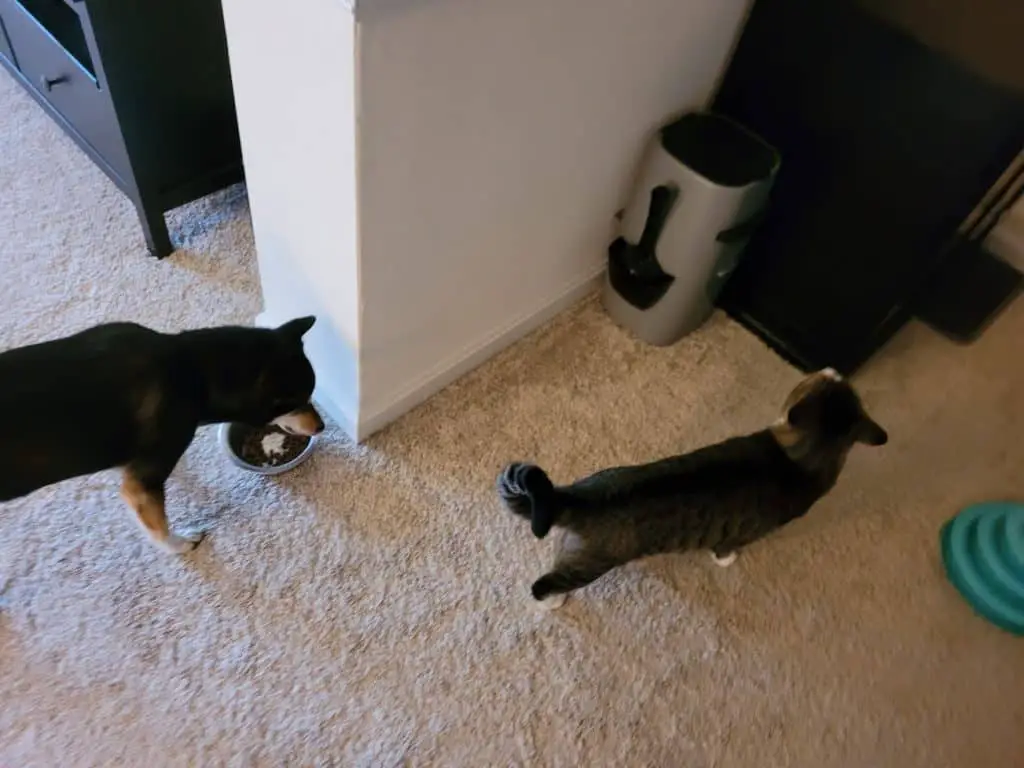
The best way to prevent food aggression is by not allowing it to happen in the first place. Dogs repeat behaviors they’re rewarded for, and protecting their food successfully is a reward for them. The best solution is: to feed your pets in separate safe places so neither can bother the other while they eat.
Possession Aggression
Possessive aggression is a well-known negative trait of Shiba Inus. This type of aggression shows signs at a young age revolving around a Shiba’s food, territory, and most commonly their toys. This character flaw can be directed at both people and other pets.
Spotting and minimizing possessive behaviors is similar to managing food-based aggression. Both revolve around three fundamental parts:
- Something your Shiba Inu wants or is actively interacting with.
- Your Shiba Inu.
- A third party who’s seen as a potential threat by your pet.
And the best way of preventing possessive behaviors is by socializing with your Shiba Inu. Proper social training reduces Shiba’s stress and helps you build a trusting bond with them. Both of which are critical for managing bad behavior.
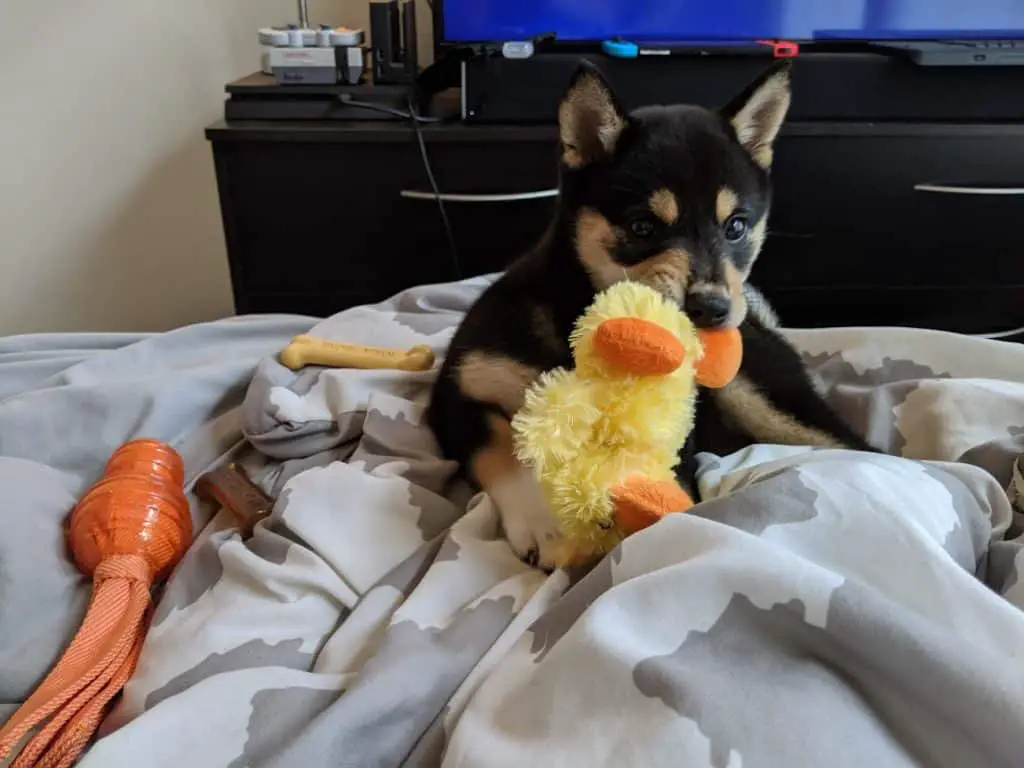
I usually run into this issue when my Shiba Inu has something she isn’t supposed to have. For me it’s usually a piece of trash, sometimes table scraps, or rarely even a toy she’s chewing on. And the way you need to approach this situation depends on what exactly is going on. Here are two potential scenarios:
Your Shiba has something they aren’t supposed to have.
The last thing you want to do is yell at your pet and try to snatch whatever they have away from them. That’s a recipe for disaster, not only does it stress your dog out it almost guarantees they’ll bite you. What you want to do is:
- Calmly say their name and ask them to either “drop it” or “leave it”. This is the ideal outcome, but if that doesn’t work.
- Redirect their attention with a treat or toy. It doesn’t have to be anything particularly special, but offering your pet something in an exciting tone tells them what you have is better. Once they’ve shifted their focus, calmly take the thing they had.
Your Shiba is chewing on a toy and another pet walks up to them.
This is one of the most common forms of aggression Shiba Inus exhibits. The things that have worked best for me in these kinds of situations are:
- The “nicely” command. This is a general catch-all I use when Faith starts acting up, usually with our cat.
- Controlled social interactions. It feels like socializing is the cure-all for bad Shiba behavior, and that’s because it is. Shiba Inus are an ancient breed noted for having primitive responses to social situations, but they’re quick learners. I start a play session between myself and both pets in question. Splitting my attention and behavioral corrections equally between the two of them.
- Reduce the odds by removing “high value” items. Leaving toys on the floor is a great way of letting your Shiba access whatever interests them at that moment. It’s best to keep a dogs toys on a rotation to keep things fresh and interesting in their eyes. Section out their toys into groups and cycle between them weekly.
After consistent training and redirection, I’ve almost completely stopped my Shiba Inu’s possessive behavior around toys in a few short weeks. She isn’t perfect with bits of trash but she no longer snaps at me, opting to voice her disapproval with minor growling even though she lets me take it from her anyway.
Social-Conflict Aggression
Most social aggression starts when a Shiba Inu feels stressed or threatened. Tightening their leash, being charged at by another dog, or another pet pawing them during a social interaction are common causes in the moment. The underlying problem is a lack of socialization from a young age.
You typically see warning signs of social aggression when a Shiba Inu is a puppy or adolescent, from 12 to 36 months old. This is the period of their life where they’re going through the last of their hormonal changes and solidifying any habits or behaviors they’ve learned.
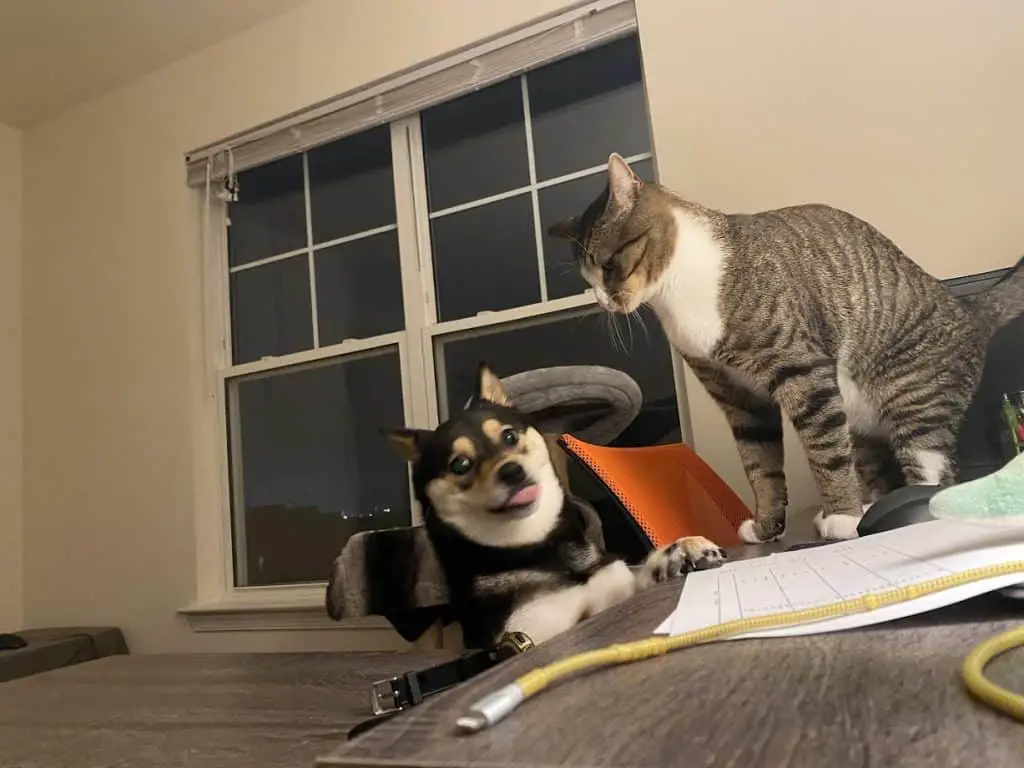
Female Shibas typically show signs while puppies while males, especially intact ones, begin displaying socially aggressive behaviors as they transition into an adult.
Some common symptoms of social conflict are:
- Baring teeth
- Freezing in place
- Growling
- Lowered ears
- Trembling
- Tucked tail
Social interactions are crucial for a Shiba Inu’s development, and knowing how to spot a potentially sour situation is equally as important.
I typically run into this when I’m walking Faith and a larger dog walks up to us. We’ll chat for a little bit and ask if it’s ok for the two of them to meet, then we slowly approach. The initial interaction usually goes well but Faith will lock up and start to growl, before snapping when they start nosing her.
We’ll split the two of them up, I’ll apologize, and then I’ll make sure Faith is alright. Thankfully that’s something I can improve by getting her used to being around larger pets. And the best way I’ve found to do that is by going on a hike.
Most of the people you run into have larger dogs, on and off-leash, are very friendly, and don’t mind a quick chat.
Aggression Towards Other Dogs
Shiba Inus are commonly aggressive towards other dogs due to their dominant nature. They are naturally stubborn, territorial, and reserved character trails. Their self-sufficient hunters companion background lead this breed to develop a number of anti-social behaviors.
Those are the reasons socializing is so crucial for this breed. For extreme cases it can be the different between having friends and family over or going on a walk without an episode.
Fortunately, most Shiba Inus aren’t that bad. But socializing with other dogs, especially at first, will lead to a few growls, snapps, and quarrels. When entering a social situation with another dog, try:
- Calm down. Just like how other people can lock up if your stressed, your pet can as well.
- Take control with a shorter leash. Don’t let your Shiba Inu drag you around.
- Start by getting passing or being near other dogs. Don’t jump off the deep end into a play session when your Shiba isn’t ready.
- Properly correct them by tugging up on their leash. A shorter leash, or hold, gives you leverage. Use it to get their control with minimal effort.
- Consistency is key. Your pet can’t learn to be around other dogs if you don’t make it a focus.
- Slowly up the difficulty. Have them meet face-to-face for a few seconds, then break away.
Predatory Aggression
Today, most Shiba Inus aren’t used as hunting dogs. But due to their background as hunters the slightest movement, rustle in a bush, or scent can set them off on a wild goose chase. That high prey drive is why it’s strongly recommended you keep them on a leash, and don’t pair them with cats.
My Shiba Inu, like many others, struggles with this. Mindless leash pulling and overly aggressive play with smaller animals are the main two types of predatory aggression I run into. Thankfully we’ve been able to make improvements in both of these areas, here’s what worked for me.
Chasing While On A Leash
I’ve heard from other Shiba owners that regular old leash training has worked for them, but it didn’t for me. I didn’t start having any success reducing Faith’s mindless leash pulling and chasing until I got a pinch collar.
She instantly went from ignoring my commands to falling right in line. There are ties she tests it, but those are few and far between. I will warn you, just starting your dog off with a pinch collar does do much. We had about two months of steady leash training under our belt.
Aggressive Play With Smaller Pets
You’ll run into this some while out on walks but you’ll see it most often at home. Chasing, persistent nipping, barking, and sometimes wild growling are common warning signs.
This is another place where I’ve had some success with a “nicely” command. I use that as a warning that she needs to be nice before I get involved. She always ignored it for around a week then started realizing she gets to play with our cat longer when she listens. And yes, I said cat.
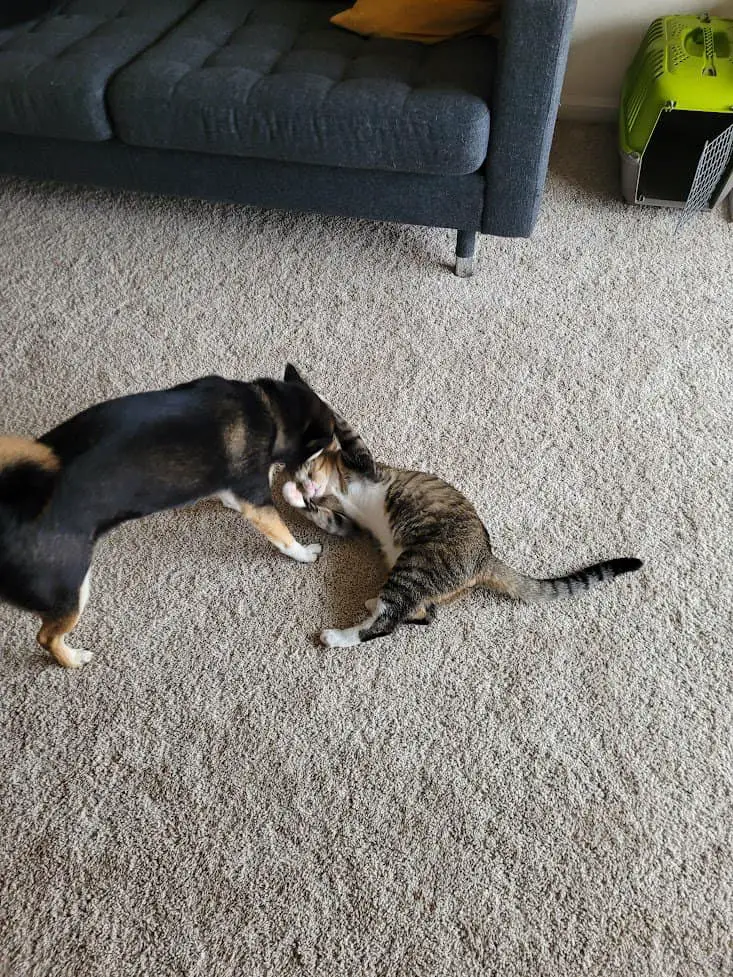
While it isn’t recommended due to their prey drive, it’s possible for a cat and Shiba Inu to get along. For the best results, you’ll want to introduce them to each other while they’re young with a healthy dose of supervision. It isn’t a guaranteed match, but don’t think it’s outright impossible.
Summary On Aggression
Remember there is no quick fix, these things take time and consistent effort. Be sure you reward behaviors you like and properly handle ones you don’t.
Avoid incentivizing anger by not using it against them. Hitting and yelling at your pet only teaches them to fight aggression with aggression, which is the opposite of what you want.
Pay attention to the little things your Shiba Inu does before and after things go sour. Ask yourself:
- What warning signs did I see?
- Did I play a role in this?
- Could I have handled things better?
Take your time and handle things with care. Rushing to a solution is a temporary remedy that only results in a worse outcome on their next offense.
Frequently Asked Questions
Why Are Shibas So Aggressive?
Shiba Inus are not as aggressive as other dog breeds. However, they have a high prey drive, loads of energy, a stubborn personality, and a desperate need for proper social training. Most aggressive behavior is triggered by the stress of a new social interaction.
Investing the time to properly socialize your Shiba reduces stress, minimizes aggression, improves their quality of life, and helps the two of you build a stronger bond together.
Why Do Shibas Bite So Much?
Shiba Inus are full of energy and love to play, and since a dog’s mouth is their best tool, biting is common. Most of the time it isn’t out of malice and a simple redirection solves the problem. Redirect their attention from your hands and fingers to a toy. The more you do this the less likely they are to nip during play.
Are Shiba Inu Aggressive Towards Humans?
Shiba Inus are loyal family dogs but have a nasty tendency of being possessive over toys, food, and territory. That aggressive behavior can be directed at another pet, an object they don’t recognize, somebody they have not met before, or even you as their owner.
Are Male Or Female Shiba Inus More Aggressive?
Male Shiba Inus have more aggressive tendencies, especially if they are intact. Usually in social interactions and with resource guarding like food or toys. Female Shiba Inus are less aggressive than males. However, females are more likely to be aggressive towards other females if they’re unspayed and tend to be more territorial.
